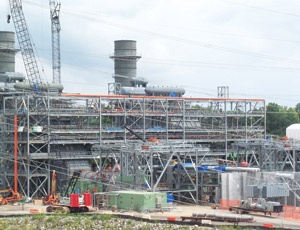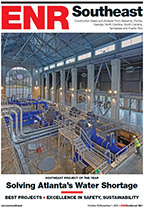Electric utility executives are often asked, “What kind of power plants will we need? Nuclear? Natural gas? Clean coal? Biomass? Solar?” A common answer is, “All of the above.”

But only one U.S. utility is already developing just about every type of powerplant imaginable: Atlanta-based Southern Co., the corporate parent of Georgia Power, Gulf Power, Alabama Power, Mississippi Power, nuclear operator Southern Nuclear and wholesale generator Southern Power.
And few, if any, public or private entities of any kind in the Southeast could match Southern Co.’s plan to invest at least $15.1 billion—and perhaps as much as $17.4 billion—on capital projects, including new generation, transmission and environmental efforts, over the next three years alone.
Those are two good reasons for naming Southern Co. as ENR Southeast’s Owner of the Year.
Even the deep economic downturn has not slowed the pace of design and construction activity at Southern. Its four utility subsidiaries and Southern Power unit are building a remarkable variety of projects.
“We’re meeting our customers’ needs not from one source, but from a variety of sources,” says Anthony Topazi, Southern Co.’s chief operating officer. “A diverse portfolio is good for our customers; it’s not healthy to be overly reliant on any one type of generation.”
For example, Topazi says, Georgia Power and the co-owners of the two-unit Vogtle nuclear station in Waynesboro, Ga., are preparing the site for two new 1,117-MW nuclear units. Vogtle units 3 and 4, in which Georgia Power holds a 45.7% ownership interest, will be the nation’s first new nuclear units when they begin commercial operation in 2016 and 2017, respectively.
 Georgia Power also is building three 840-MW, gas-fired combined-cycle units in Atlanta to replace older coal-fired generation, says Topazi, while Mississippi Power has received regulatory approval to build a 582-MW integrated gasification/combined cycle (IGCC) unit that will be powered by locally mined lignite.
Georgia Power also is building three 840-MW, gas-fired combined-cycle units in Atlanta to replace older coal-fired generation, says Topazi, while Mississippi Power has received regulatory approval to build a 582-MW integrated gasification/combined cycle (IGCC) unit that will be powered by locally mined lignite.
Southern Power, meanwhile, is building a 720-MW, gas-fired “peaking” facility in Cleveland County, N.C., that will sell its output to several municipal utilities and electric cooperatives. Still other projects are in construction or planning.
There are several “drivers” for this level—and diversity—of plant construction activity, says Topazi. “The Southeast has been and will continue to be one of the fastest-growing parts of the country,” he says.
And increasingly stringent environmental regulations are leading utilities to reduce their carbon footprints by retiring older coal units and building new nuclear, gas and “21st-century coal” projects, as well as expanding their portfolios of renewable energy.
Industry analysts have noticed Southern’s commitment to diversifying its power generation. Paul Patterson, an energy analyst at Glenrock Associates, a New York City-based research firm, says that Southern’s management team “has their eye on the ball.”
Prudent diversification
Diversifying Southern’s generation portfolio by adding new nuclear, gas-fired, IGCC and renewable units “appears to be the prudent thing to do,” given the ongoing uncertainty about federal regulation of greenhouse gases and other pollutants, Patterson says.
“We also have an unprecedented transmission construction program under way to connect our new generation to the grid and to keep pace with growing demand from our customer base,” Topazi says. Further, Southern continues to make hundreds of millions of dollars in “smart-grid” improvements to maintain its grid’s position as the nation’s most reliable.
On the emission-control front, Southern Co. already has added “scrubbers”—or flue gas desulfurization equipment—and selective catalytic reduction devices to 60% of its utilities’ coal-fired units, says Penny Manuel, Southern’s executive vice president of engineering and construction services.
“The Southeast has been and will continue to be one of the fastest-growing parts of the country.”
—Anthony Topazi, chief operating officer, Southern Co.
Now, Southern’s utilities are adding emission controls to its Plant Scherer in Juliette, Ga.; Plant Crist in Pensacola, Fla.; Plant Miller in Quinton, Ala.; and—pending regulatory approvals—Plant Daniel in Moss Point, Miss., Manuel says.
Topazi says that other environment-related work by Southern over the next three years will depend in part on the final rules developed by the U.S. Environmental Protection Agency.
Southern’s “base” capital spending plan for the 2011-13 period is $14.4 billion, and includes $2.2 billion for work on Georgia Power’s share of the Vogtle nuclear expansion, $2 billion for work on Mississippi Power’s IGCC plant, $1.8 billion for new transmission and distribution lines and $4 billion for maintenance of existing plants, transmission and distribution.
Southern also figures on spending another $700 million to $2.9 billion on projects tied to upcoming regulatory decisions by the EPA and others.
Southern has gained special notice, of course, for being the first U.S. company to advance to construction the next generation of nuclear projects. Georgia Power and the other co-owners of the Vogtle station signed a multibillion-dollar engineering-procurement-construction contract with Shaw Group and Westinghouse in 2008 for two AP1000 nuclear units, and in 2009 secured an early site permit for Vogtle units 3 and 4 from the Nuclear Regulatory Commission.
Excavation, earthwork and other site preparation already are well under way, and the project team plans to begin construction of unit foundations as soon as the NRC issues a combined construction and operating license.
Southern hopes to have the COL in hand by the end of this year, says Joseph “Buzz” Miller, executive vice president of nuclear development for Southern Nuclear. And that will mark another milestone in the much-discussed nuclear renaissance, proving it to be a reality, and a new phase in the life of Southern Co.



Post a comment to this article
Report Abusive Comment